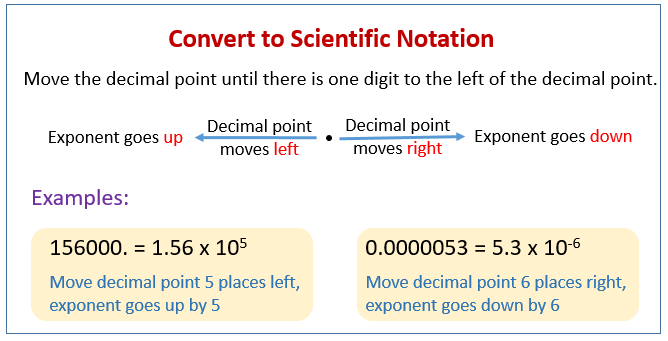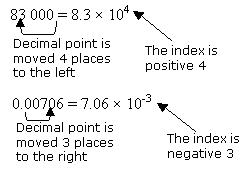Convert A Number To Scientific Notation
Scientific notation is a way to express very large or very small numbers in a compact, standardized format. It is especially useful in science, engineering, and mathematics to simplify calculations and represent extreme values clearly.
What is scientific notation?
Very large or very small numbers are usually written in scientific notation:
A × 10n where
- 1 ≤ |A| < 10. This part is called the significand or mantissa.
- n is an integer. This part is the exponent or power of 10.
Example:
2 350 000 = 2.35 × 106
0.000 875 4 = 8.754 × 10–4
How to Convert A Number To Scientific Notation?
The following figures show how to convert decimals to scientific notation. Scroll down the page for more examples and solutions.

Scientific Notation Worksheets:
Practice your skills with the following worksheets:
Online & Printable Scientific Notation Worksheets
Steps to convert a number into scientific notation:
- Locate the Decimal Point
If the number has an explicit decimal point, identify its location.
If the number is a whole number, the decimal point is considered to be at the end of the number. - Move the Decimal Point
Move the decimal point to the right of the first non-zero digit.
- For numbers greater than or equal to 10: Move the decimal point to the left until there is only one non-zero digit to its left. The number of places you moved the decimal point will be the positive exponent (n).
- For numbers between 0 and 1: Move the decimal point to the right until it is after the first non-zero digit. The number of places you moved the decimal point will be the negative exponent (-n).
- For numbers between 1 and 10: If the number is already in the scientific form.
- Write in Scientific Notation Form
Once you have determined the position of the decimal point for the significand (A) and the value of the exponent (n), write the number in the form a × 10n.
Summary:
- If you move the decimal point to the left, the exponent is positive.
- If you move the decimal point to the right, the exponent is negative.
- If you don’t move the decimal point (number is between 1 and 10), the exponent is zero.
Example:
Write each of the following numbers in scientific notation:
a) 83 000 b) 0.00706
Solution:

Example:
Write each of the following numbers in scientific notation:
a) 734 000 b) 0.00685
Solution:
a)

b)

The following video shows more examples of converting numbers to scientific notation
Learn how to convert in and out of scientific notation in these step by step examples
Try out our new and fun Fraction Concoction Game.
Add and subtract fractions to make exciting fraction concoctions following a recipe. There are four levels of difficulty: Easy, medium, hard and insane. Practice the basics of fraction addition and subtraction or challenge yourself with the insane level.

We welcome your feedback, comments and questions about this site or page. Please submit your feedback or enquiries via our Feedback page.